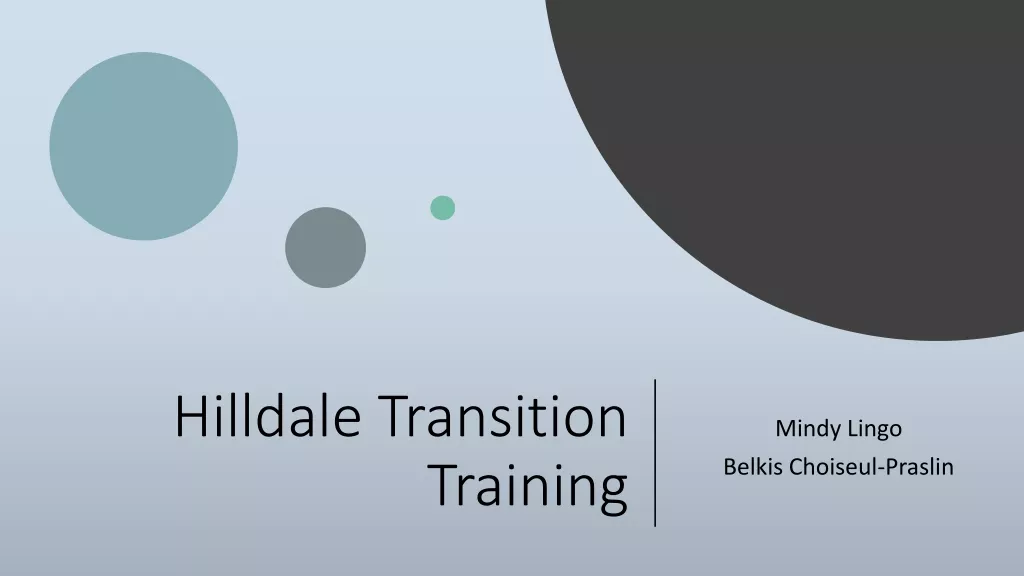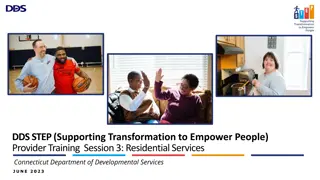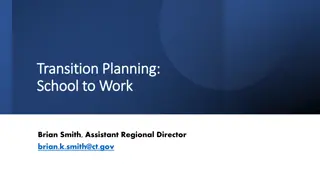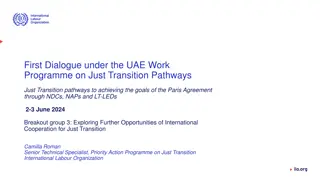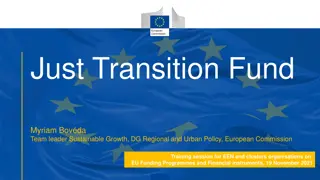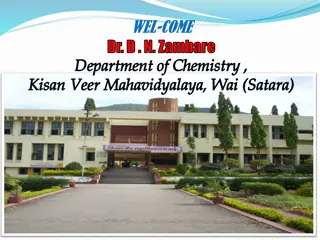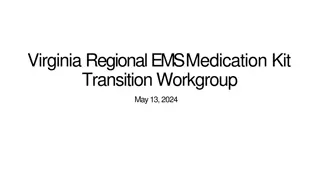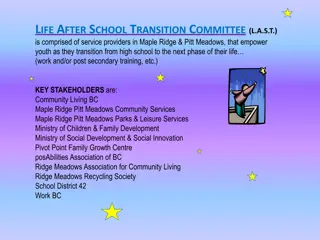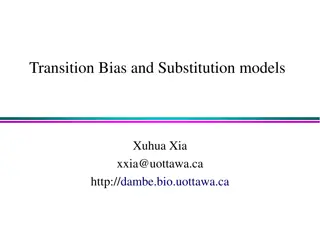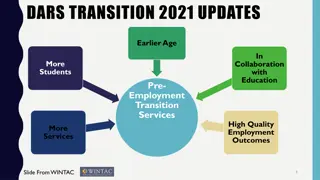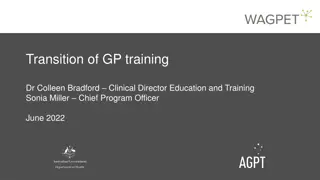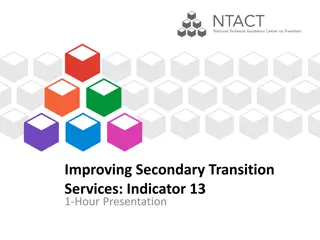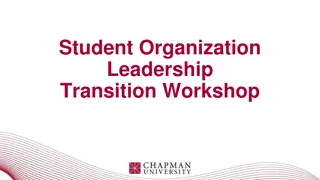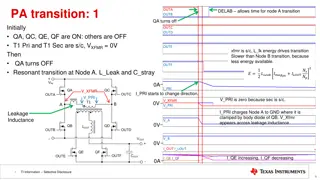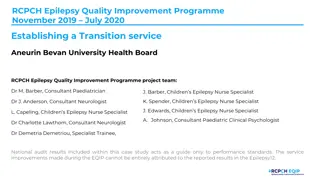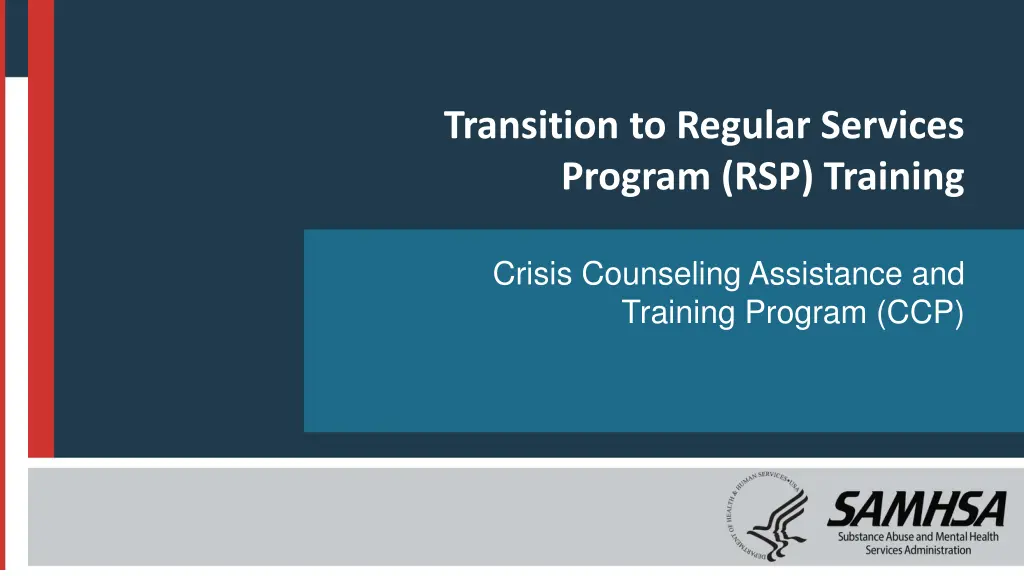
Transition to Regular Services Program Training
Explore the Transition to Regular Services Program (RSP) Training and Crisis Counseling Assistance and Training Program (CCP) course agenda, objectives, guidelines for working together, and getting started activities.
Download Presentation

Please find below an Image/Link to download the presentation.
The content on the website is provided AS IS for your information and personal use only. It may not be sold, licensed, or shared on other websites without obtaining consent from the author. If you encounter any issues during the download, it is possible that the publisher has removed the file from their server.
You are allowed to download the files provided on this website for personal or commercial use, subject to the condition that they are used lawfully. All files are the property of their respective owners.
The content on the website is provided AS IS for your information and personal use only. It may not be sold, licensed, or shared on other websites without obtaining consent from the author.
E N D
Presentation Transcript
Transition to Regular Services Program (RSP) Training Crisis Counseling Assistance and Training Program (CCP)
Introductions Please introduce yourself by sharing the following: Your name and pronouns Two things you re grateful for that begin with your initials Your role or position in the CCP 2
Getting Started Activity Option 1 20 Fun Things (30 minutes)
Getting Started Activity Option 2 Symbols and Statements Activity (30 minutes)
Getting Started Activity Option 3 Personal Crest (30 minutes)
Objectives By the end of this course, you will be able to do the following: Identify issues that occur when transitioning from Immediate Services Program (ISP) to Regular Services Program (RSP). Define the goals and objectives of the RSP. Identify ongoing and emerging disaster reactions related to the current phase of the disaster. Describe crisis counseling services related to the current phase. Practice crisis counseling skills. Complete data collection forms correctly. Update personal and organizational strategies for managing stress. 7
Guidelines for Working Together Keep time (start on time, return from breaks on time, end on time). Switch mobile phones off or to vibrate. Participate fully. Ask questions freely. Balance talking and listening. Respect each other s points of view. Use person-first language, i.e., person with a disability. 8
Course Agenda Day 1 Day 2 AM Sessions AM Sessions Welcome and Introductions Crisis Counseling Services (cont.) Getting Started Activity Data Collection and Program Evaluation Transition From ISP to RSP Stress Management for Staff Current Disaster Reactions, Strengths, and Resilience Team Building Activity PM Sessions PM Sessions Applying Your Learning Lunch Course Evaluation Crisis Counseling Services and Interventions Adjourn Individual/Family Crisis Counseling Group Crisis Counseling Adjourn 9
Section 1Transition From ISP to RSP CCP Timeline Goals of the RSP Program Management Program Services Issues 10
Session Objectives Identify ISP-to-RSP transition issues. Define the goals of the RSP. 11
CCP Timeline Where is your CCP in the typical timeline? 12
Goals of the RSP During the transition it is important to emphasize the following: Reflecting on the ISP what stands out for you? Successes and accomplishments Challenges Looking ahead to the RSP: What do you need to pay attention to during the transition? What lessons learned from the ISP can you bring to the RSP? What do you want to see the RSP accomplish? What challenges do you anticipate? 13
Goals of the RSP (cont.) During the transition it is important to emphasize: Ongoing needs assessment Continued focus on individual and family services Fostering of individual and community resilience Continued identification of special populations Services of lower intensity and higher volume 14
Goals of the RSP (cont.) Focus on: Group crisis counseling, public education, and media messaging Targeted outreach to special populations Increased community networking Assessment and referral Resource linkage 15
Goals of the RSP (cont.) Focus on: Reassessment of training needs Continued stress management Analysis and use of program data Comprehensive quality assurance process Program legacy for individuals, community, and staff 16
Program Management RSP administrative structure: 17
Program Management (cont.) Emphasis should be on a review of: Needs assessment and outreach strategy Staffing plan Crisis counseling services Supervision and team meetings Training 18
Program Management (cont.) The following areas will be reviewed and assessed during the transition to RSP: Fiscal management Quality assurance Stress management Data collection and evaluation Program media and marketing 19
Program Services Survivors reactions will change over time, resulting in the need for programmatic changes in the RSP. There will be an increased need and opportunity for group crisis counseling and public education. Survivors may experience deepened anxiety or depression as the new reality of life after disaster sets in. While every disaster is different, there are some reactions that can be anticipated. 20
Section 2Current Disaster Reactions, Strengths, and Resilience Review of Key Concepts What Individual Reactions Have We Seen? What Strengths Have We Seen? How Are We Fostering Resilience? 21
Session Objective Identify ongoing and emerging disaster reactions related to the current phase of disaster. 22
Review of Key Concepts Have you observed the following? Everyone who experiences a disaster is affected by it in some way. People pull together during and after a disaster. Stress and grief are common reactions to uncommon situations. People s natural resilience will support individual and collective recovery. 23
Review of Key Concepts (cont.) Typical outcomes of disaster: Some will have severe reactions. Few will develop diagnosable conditions. Most do not seek help or treatment. Survivors often reject help. 24
Review of Key Concepts (cont.) Two types of disaster impacts: Individual disaster impact: May cause stress and grief May cause fatigue, irritability, hopelessness, and relationship conflicts Collective disaster impact: May damage community support May affect individual coping 25
Review of Key Concepts (cont.) Collective Reactions Source: Zunin/Meyers, as cited in U.S. Department of Health and Human Services. (2000). Training manual for mental health and human service workers in major disasters (DHHS Publication 90 538). Washington, DC: U.S. Department of Health and Human Services, Substance Abuse and Mental Health Services Administration , Center for Mental Health Services. 26
Review of Key Concepts (cont.) Risk Factors Population Exposure Model A. Injured survivors; bereaved family members B. Survivors with high exposure to disaster trauma or evacuated from disaster zones C. Bereaved extended family and friends, first responders D. People who lost homes, jobs, or possessions; people with preexisting trauma and dysfunction; special populations; other disaster responders E. Affected people from the larger community Adapted from DeWolfe, D. (2002). Mental health interventions following major disasters: A guide for administrators, policy makers, planners, and providers. Rockville, MD: U.S. Department of Health and Human Services, SAMHSA, CMHS. 27
What Individual Reactions Have We Seen? Types of individual reactions: Physical Emotional Cognitive Behavioral 28
What Individual Reactions Have We Seen? (cont.) Activity: With a partner: Draw a map of the phases of this disaster what you ve observed to date and projecting into the future. Use the template in your workbook. Identify the typical individual reactions you re seeing. Identify potential future trigger points. You have 10 minutes. 29
What Individual Reactions Have We Seen? (cont.) Anticipated reactions: Anger around the limits of governmental assistance and insurance (e.g., the system, red tape ) Increased substance use Unaddressed trauma leading to diagnosable conditions such as depression or posttraumatic stress disorder (PTSD) Stress from financial hardship as resources diminish Frustration and disillusionment at the lack of resources and pace of repairs Continued anxiety around dislocation and separation 30
Activity Identifying Immediate and Long-term Reactions Separate into groups based on teams, providers, or regionally. Select a recorder. On top of the paper, write immediate in top left corner. On the top right corner, write over time. Draw an arrow from immediate to over time. You will have 15 minutes to: Identify how immediate reactions may evolve into intermediate and then long-term reactions. Focus on individual and community reactions, not interventions. *After 15 minutes, you will report out. 31
What Individual Reactions Have We Seen? (cont.) The severity of reactions is affected by the type of, level of exposure to, and casualties associated with the disaster. Preexisting trauma may increase the risk of severe reactions. CCP staff members refer anyone for treatment experiencing severe reactions. Preexisting levels of support will affect the severity of reactions. 32
What Individual Reactions Have We Seen? (cont.) Severe reactions may be a sign of the following: Depressive disorders Suicidal behavior Substance misuse Acute stress disorder PTSD Dissociative disorders Anxiety disorders 33
What Individual Reactions Have We Seen? (cont.) Severe reactions: Significantly affects life functioning (school, work, relationships, etc.) Presents a health or safety risk, including suicidal behavior Does not resolve or diminish over time How do you recognize when a reaction becomes severe? When does a severe reaction warrant referral? How are you using the Assessment and Referral Tools for adults and for children? 34
Activity: Part 1, Talk at Tables: What Survivors Have Been Reached? Who Still Needs Service? For the next 10 minutes, talk at your tables about successes, challenges, and next steps in reaching special populations. Discuss: The groups the CCP has been most successful at connecting with Groups that haven t been reached and the plan for reaching them Unanticipated challenges and unique issues discovered during the ISP in serving some populations Share strategies for engaging special populations 35
What Strengths Have We Seen? What individual strengths have you seen? What collective strengths have you seen? What examples of personal growth have you seen? 36
Resilience The American Psychological Association (APA) identifies four core components of resilience: Connection Wellness Healthy thinking Meaning and purpose Resilience: an ability to recover from or adjust easily to misfortune or change APA, 2020, https://www.apa.org/topics/resilience/building-your-resilience 37
How Are We Fostering Resilience? How have you seen these factors affect survivors resilience? Life situation Individual traits and coping styles Disaster and trauma experience Family and social support Spiritual beliefs Presence of perceived control and hope Availability of accurate information An effective and caring emergency response 38
How Are We Fostering Resilience? (cont.) How have you helped survivors to: Reach out to people they trust and care about (connection)? Engage in self-care and mindfulness practices such as healthy eating, journal writing, yoga, prayer, or meditation (wellness)? Maintain a hopeful outlook (healthy thinking)? Set realistic goals and take steps to carry them out (meaning and purpose)? Focus on finding solutions (meaning and purpose)? 39
How Are We Fostering Resilience? (cont.) Which of the following have you taught survivors? Making connections Avoiding seeing crises as insurmountable problems Accepting change as a part of living Moving toward goals Taking decisive action Looking for opportunities for self-discovery Nurturing a positive view of self Keeping things in perspective Maintaining a hopeful outlook Practicing effective self-care 40
How Are We Fostering Resilience? (cont.) Complete the self-assessment checklist in your workbook, page 16. Make a check mark next to the tools you feel you help survivors to use. For the ones you checked, make some notes about how you do this, including specific examples. 41
Section 3Crisis Counseling Services and Interventions Needs Assessment and Outreach Range of Crisis Counseling Services Individuals/Families Groups Communities Public Education and Media Messaging Assessment, Referral, and Resource Linkage Ethical Considerations Cultural Awareness 42
Session Objective Describe crisis counseling services related to the current phase. 43
Needs Assessment and Outreach Needs assessment is an ongoing process whereby new information is brought into the program, and program outreach and services are adjusted to meet emergent needs or discovered special populations. Program outreach and services are adjusted to meet identified needs. 44
Activity: Part 2, Share With the Group: Who Still Needs Service? How Can We Reach Them? Identify characteristics, demographics, and geographic indicators to identify survivors who still need service and to what degree. How can the CCP use outreach and needs assessment to reach these segments of the population? What are steps to be included in an action plan as services are refocused on reaching the unserved or underserved survivor population? 45
Range of Crisis Counseling services Individual/family crisis counseling Brief educational or supportive contact Group crisis counseling: Support and educational groups Self-help groups Assessment, referral, and resource linkage Community support and networking Public education Development and distribution of educational materials Media messaging and risk communications Virtual services 46
Individuals/Families Goals of individual/family crisis counseling assist participant(s) in doing the following: Understanding their situations and reactions Regaining a sense of mastery and control Identifying, labeling, and expressing emotions Adjusting to the disaster and losses Managing stress Making decisions and taking action Developing coping strategies Using community resources 47
Groups Where are we now? What types of groups are you providing, or planning to provide? What are the common themes? What s working well about these groups? What s been challenging? Where are we going? What communities have emerged that would benefit from forming a group? 48
Groups (cont.) Goals of group crisis counseling assist group members in doing the following: Understanding their current situations and reactions to the disaster Achieving mutual support Developing skills related to stress management, coping with triggers, expressing emotions, and problem solving Becoming knowledgeable about available community resources Developing and implementing personal and group goals Ensuring cultural competency and representation of the population through the group leaders 49
Groups (cont.) Factors that affect the group process: Co-facilitation by two crisis counselors Knowledge and skills of group leaders Group leaders awareness of their own values, biases, and beliefs, and how these affect the group Respect and confidentiality Utilization of feedback from the group 50


